Abstract
To produce high-quality crops, not only excellent cultivation techniques but also accurate nutrient management techniques are important. In recent years, many nondestructive tools such as the chlorophyll meter “SPAD” and the leaf nitrogen meter “Agri Expert CCN” have been developed for measuring crop leaf chlorophyll and nitrogen contents. However, such devices are still relatively expensive for individual farmers. In this research, we developed a low-cost and small-size camera with built-in LEDs of several specific wavelengths for evaluating the nutrient status of fruit trees. A total of 2 camera prototypes were developed by integrating 3 independent LEDs of specific wavelengths (Camera 1: 950 nm, 660 nm and 560 nm; Camera 2: 950 nm, 660 nm and 727 nm) into the device. In addition, a simple software tool was developed to enable the camera to capture leaf images under different LED lighting conditions. Using the prototypes, we acquired images of apple leaves and investigated the possibility of using the images to estimate the leaf nutrient status indicator SPAD (chlorophyll) and CCN (nitrogen) values obtained using the above-mentioned standard tools. The results indicate that the Camera 1 prototype is superior to the Camera 2 prototype and can potentially be applied to the evaluation of nutrient status in apple leaves.
1. Introduction
To produce high-quality apples to meet the rapidly growing market demand, key cultivation techniques such as artificial pollination, pruning of branches, thinning of flowers and fruits and bagging or rotating on-tree fruits have been adopted and widely practiced in Japan [1,2]. In recent decades, in addition to these meticulous cultivation techniques, optimal fertilization and nutrient management have attracted considerable attention in fruit production [3,4]. Precision nutrient management strategies have been proposed to replace conventional fertilizer practices for apple orchards [5,6]. Conventional fertilizing practices apply the same amount of fertilizer to the orchard regardless of the in-field variations in soil fertility and crop nutrient status, which raises the risk of overuse or underuse in different areas, resulting in less yield and fruit quality. In comparison, precision nutrient management strategies are characterized by site-specific and need-based nutrient management practices, which necessitate a thorough understanding of the nutrient status of the orchard on an individual tree basis [7,8]. It is therefore important to timely and accurately evaluate the nutrient status of individual trees in different growth stages when precision nutrient management strategies are implemented in orchards [9,10].
Chlorophyll is not only a pigment that gives the plant its green color, but is also an essential component for the conversion of light energy to stored chemical energy in the process of photosynthesis, which sustains plant life and promotes its growth. The chlorophyll pigment content in a leaf is directly related to the amount of solar radiation absorbed by the leaf, and eventually determines the photosynthetic capacity of the plant [11,12]. On the other hand, nitrogen is the most essential nutrient for crop production [13]. Particularly, in fruit production, it is directly involved in flower bud formation, flowering, fruit setting and development. For example, previous studies have found that the availability of nitrogen significantly influenced flowering intensity and the fruit set in olive trees [14]; higher nitrogen was correlated with budburst, flowering and fruit set, and improved the crop performance in peach trees [15]; and increasing nitrogen supply could lead to more cells per fruit, larger fruit and higher soluble solids in apple trees [16]. However, the excessive absorption of nitrogen in plants may lead to a deterioration in fruit quality, whereas a lack of nitrogen may cause significant yield reduction [17].
Traditionally, solvent-based leaf pigment extraction combined with spectrophotometric determination in solution [18] has been used to measure chlorophyll content, while the Kjeldahl method [19] and Dumas combustion digestion [20] have been used to quantify nitrogen concentration in plants. However, these methods depend on a destructive approach, and usually take a great deal of effort, time and money. Much research has demonstrated the potential of various optical sensors, reflectometers and image-based sensors in estimating these two indicators of crop nutrient status [10,21,22,23,24,25,26,27,28,29]. Numerous studies have investigated the relationships between the spectral characteristics of specific wavelengths and leaf chlorophyll/nitrogen contents, and based on which a variety of useful vegetation indices have been successfully developed for estimating the chlorophyll/nitrogen contents in crops [30,31]. Furthermore, based on thorough experimental investigation and evaluation, several portable electronic tools such as leaf chlorophyll meter “SPAD (Soil Plant Analysis Development)” (Konica Minolta, Inc., Tokyo, Japan), leaf nitrogen meter “Agri Expert CCN (Crop Control by Nitrogen)” (Satake Co., Ltd., Hiroshima, Japan), crop NDVI (normalized difference vegetation index) meters “GreenSeeker” (Trimble Navigation Limited, Westminster, CO, USA) and “Crop Circle” (Holland Scientific Inc., Lincoln, NE, USA), leaf color meter “Rice Scan” (Maxell Co., Tokyo, Japan), etc., have been developed and commercialized. These tools have been widely used as a nondestructive, rapid, accurate and effective method for estimating leaf nutrient status in both small-scale experiments and large-scale production fields [10,32,33,34,35,36,37].
During the past few decades, the significant relationships between chlorophyll and nitrogen contents in many agricultural and horticultural crops have been revealed by numerous studies. Although chlorophyll meters are designed to determine leaf chlorophyll concentration, the close relationships between chlorophyll and nitrogen contents in plant leaves have enabled these meters to be used as a standard tool for indirectly estimating leaf nitrogen in practical applications [38,39,40,41,42,43]. Furthermore, originally, these tools were developed for site-specific and need-based nutrient management in rice [44,45,46], and later they were also proven to be effective for evaluating nutrient status in many other crops [47,48,49,50,51,52]. However, such devices are still relatively expensive for individual farmers.
Our recent study has demonstrated the possibility of a multiple linear regression (MLR) model based on the raw reflectance of four narrowband specific wavelengths in estimating the nitrogen content in apple leaves [10]. Based on the above result, this research aimed to develop a low-cost and small-size camera for evaluating the nutrient status of fruit trees. In addition to the above-mentioned MLR model for nitrogen content estimation, this study first investigated the possibility of developing a similar MLR model for estimating chlorophyll content in apple leaves. Then, two camera prototypes were developed by incorporating the identified narrowband specific-wavelength LEDs into a “Rice Scan” device. A simple software tool was developed to control the camera and lighting system. The reflectance of the narrowband specific-wavelength LED light sources was extracted from the images acquired by the camera system. Finally, testing and evaluation experiments were carried out to assess the nutrient evaluation performance of the camera prototypes by means of relating the reflectance data to the leaf nutrient status indicators obtained by two widely used chlorophyll and nitrogen meters. The results demonstrated the potential applicability of the camera prototypes in estimating the nutrient status of apple leaves.
2. Materials and Methods
2.1. Selection of Key Wavelengths for Nutrient Status Evaluation
2.1.1. Experiment
The experiments were carried out in the Fujisaki Farm of Hirosaki University, Japan (longitude 140°48′48.21″ E and latitude 40°65′61.6″ N). The most cultivated ‘Fuji’ apple trees (Malus domestica) grafted on the rootstock cultivar of ‘Marubakaidou’ (Malus prunifolia Borkh. Var. ringo Asami) at age 25 years were used in this study. The trees were planted at spacings of approximately 5 × 3.5 m and managed by the input of organic fertilizers made from apple leaves collected from the orchard. Apple leaves were collected from multiple trees in summer season (14 July 2020) and were screened to ensure a healthy, complete and undamaged status in the laboratory. In modeling analysis, because it is desirable to have a dataset with a wide distribution (variance) in the target variable (chlorophyll content), all of the leaf samples collected were first grouped via visual inspection of the leaf color, and then the leaf samples used for measurement were randomly selected from the groups. Therefore, the selected leaves exhibited large variation in degree of greenness. In the experiment, a total of 120 samples were prepared and measured within 4 h after sampling.
An ImSpector V10E (Spectral Imaging Ltd., Oulu, Finland)-based hyperspectral imaging system [10] was used to obtain hyperspectral images for the collected leaf samples. During image acquisition, a white reference board was used to obtain the white reference, and the black reference was acquired when the camera shutter was completely turned off and the lens was covered by a black lens cap. The raw images were automatically calibrated based on the above references. This system collects hyperspectral images covering the 400–1000 nm spectral range with a spectral resolution of 5 nm, and each image has a spatial resolution of 1360 × 1024 pixels. With the Scanner Unit software (JFE Techno-Research Corporation, Tokyo, Japan) attached to the system, the average spectral reflectance data for each leaf sample were extracted and pretreated using a Savitzky–Golay smoothing algorithm for further analysis.
After the nondestructive hyperspectral image acquisition, the total chlorophyll concentration in leaf samples was determined using a conventional, destructive, solvent-based pigment-extraction method combined with an absorption spectrometer [10]. A total of 4 discs with 12 mm diameters cut from each leaf sample were prepared for pigment extraction using acetone solvent. After pigment extraction, the absorbances at 645 nm, 663 nm and 750 nm in the solvents were measured using a Genesys 10 Bio UV–VIS spectrophotometer (Thermo Fisher Scientific Inc., Waltham, MA, USA). Using the equation proposed by Mackenney [53], the amounts of total chlorophylls in each leaf sample were calculated.
2.1.2. Data Analysis
During the analysis of hyperspectral data, it is always necessary to identify several so-called key wavelengths to reduce the high dimensionality of hyperspectral data. These key wavelengths can potentially be used to predict the chlorophyll content in the plant leaf. This is particularly important because the objective of this research is to develop a compact device with built-in specific-wavelength LEDs to measure the nutrient status of the plant leaf, and such a small device could not provide enough space to accommodate too many LEDs.
A few statistical methods have been proposed for selecting the key wavelengths from high-dimensional spectral data [10]. This study employed Pearson’s correlation analysis [54] to identify the key wavelengths. The correlation coefficients between the reflectance of specific wavelengths and chlorophyll content were used as a criterion. The wavelengths whose reflectance had the highest correlations with chlorophyll content in certain wavelength ranges were selected. These key wavelengths were then used to develop a chlorophyll content prediction model using a multiple linear regression (MLR) algorithm. In modeling, the sample data were divided into 2 subsets: 2/3 of the entire data (80 samples) was used as the training set to develop the model and the remaining 1/3 of the entire data (40 samples) was used as the test set to evaluate the model’s performance. Finally, the performance of the MLR model was used to assess the usefulness of the selected key wavelengths for evaluating the nutrient status of the plant leaf.
2.2. Design and Development of Camera Prototype and Software
The ultimate purpose of this research was to develop a low-cost and small-size camera for evaluating the nutrient status of fruit trees. The camera was expected to be able to capture the images of fruit leaf samples under narrowband light sources such as LEDs. The first prototype version of “Rice Scan” (Maxell Co., Tokyo, Japan) was used as the basis for the design and development of the camera prototype. “Rice Scan” is a small RGB camera developed for assessing the nutrient status in rice crops based on a leaf color index. The camera has been tested and evaluated across Japan, with varying degrees of success, and it became available in the market in 2018. However, shortly after the release of the product, due to certain reasons, the product development and services were terminated. In this study, a new camera prototype was equipped with multiple narrowband LED light sources instead of a single broadband white LED light source in “Rice Scan”. These built-in LEDs emitted the narrowband specific-wavelength lights of the key wavelengths that were identified in the preceding experimental research.
To control the camera prototype, a simple software tool was designed and developed under the Visual Studio IDE environment (Microsoft Corporation, Redmond, WA, USA). With the help of the software, the camera prototype could be easily triggered to acquire images of leaf samples under each narrowband specific-wavelength LED light condition, and the images could be saved in a computer for further analysis.
2.3. Testing and Evaluation of Camera Prototype
To investigate the feasibility of using the camera prototype to assess the nutrient status of the apple leaf, the following experiments and data analyses were performed: firstly, the chlorophyll meter “SPAD-502plus” (Konika Minolta, Inc., Tokyo, Japan) and the leaf nitrogen meter “Agri Expert CCN6001” (Satake Co., Ltd., Hiroshima, Japan) were employed to measure the SPAD (index value, a relative indicator of chlorophyll content calculated based on the absorbances of the wavelengths 650 nm and 940 nm) and CCN (nitrogen content in % calculated based on the absorbances of 4 unpublished wavelengths) values of leaf samples; secondly, the camera prototype was used to capture the images of leaf samples under the identified narrowband specific-wavelength LED light conditions; thirdly, data extraction from the images was performed and the extracted data were then related to the SPAD and CCN values for the same samples by means of multiple linear regression analysis.
During the process of data analysis, the RGB data were first extracted from the images captured using the two camera prototypes. Because the prediction models for chlorophyll and nitrogen contents were developed based on the reflectance of key wavelengths, the reflectance intensity of specific-wavelength light emitted from the built-in LEDs needed to be calculated from the raw RGB data. To obtain the reflectance intensity of the specific-wavelength LED emissions, the raw RGB data were converted to L*a*b* values. In an L*a*b* color space, the L* value is a measurement of the lightness or amount of light reflected; the a* value indicates the intensity of the red (+ values) or green (− values) color and the b* value indicates the intensity of the yellow (+ values) or blue (− values) color [55]. Therefore, the L* value represents the reflectance intensity of a specific-wavelength LED light, and can potentially be used to predict chlorophyll and nitrogen contents with the prediction models developed.
In this study, we investigated the possibility of using the data captured using the camera prototypes to predict the SPAD and CCN values. The L* values of the specific-wavelength LEDs obtained for each prototype were used to develop multiple linear models for predicting the SPAD and CCN values. Considering the leaf color values obtained under the specific-wavelength LED illuminations may provide valuable nutrient-related information; the a* and b* values in addition to the L* values and the raw RGB values were also used to develop prediction models.
Because the commercial “SPAD” and “Agri Expert CCN” meters have been widely used in agricultural fields as the nondestructive standard tools to evaluate the nutrient status of plant leaves, a high correlation between the data obtained by the prototype and the SPAD and CCN values would confirm the possibility of the prototype being used as an alternative to these two standard tools.
3. Results and Discussion
3.1. Characteristics of Reflectance Spectra
Figure 1 shows the reflectance spectra obtained in the experiment. Significant differences in the reflectance intensity of certain wavelengths, particularly those in the green to red, the red edge and the near infrared wavelength ranges were found among the leaf samples (Figure 1a). Leaf samples were grouped with different levels of chlorophyll content, and the average reflectance of the groups was calculated (Figure 1b). It was found that as the levels of chlorophyll content increased, the group average reflectance spectra shifted downward sequentially, forming an orderly distribution of group spectra. Particularly, the wavelengths in the green to red and the red edge spectral ranges demonstrated larger reflectance intensity differences among different groups. This suggests that these wavelength ranges may be more closely associated with the chlorophyll content in apple leaves than other wavelengths. Our previous research also showed the similar relationship between reflectance intensity and nitrogen content in apple leaves and confirmed the usefulness of several key wavelengths in these ranges in estimating the nitrogen content in apple leaves [10].
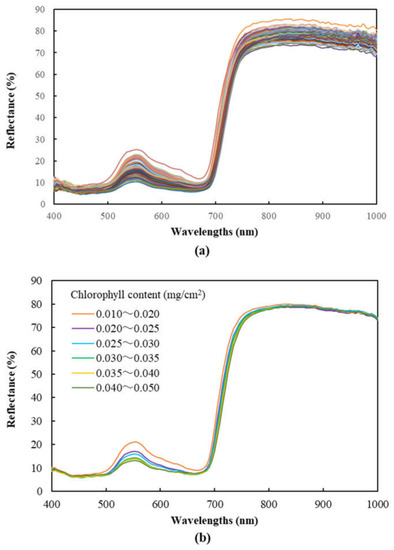
Figure 1.
Spectral reflectance characteristics of ‘Fuji’ apple leaf samples: (a) all individual leaf samples (each line indicates the reflectance spectrum of an individual leaf sample); (b) the average of leaf sample groups with different levels of chlorophyll content.
3.2. Correlation between Spectral Reflectance and Chlorophyll Content
Pearson’s correlation coefficients between leaf chlorophyll content and the reflectance of each wavelength are illustrated in Figure 2. The reflectance of most wavelengths individually showed a negative correlation with chlorophyll content. Among them, the wavelengths 710 nm and 560 nm demonstrated the highest negative correlations, achieving a significant correlation coefficient of −0.889 and −0.776 (p < 0.001), respectively. The wavelength 675 nm, whose correlation coefficient with chlorophyll content was the peak but the lowest in the range between the above 2 wavelengths (r = −0.229, p < 0.001), could be recognized as a characteristic wavelength because it possesses a significant feature in spectral reflectance compared to its longer or shorter adjacent wavelengths. Our previous study [10] revealed that the reflectance of the wavelengths around 560 nm (green) and 710 nm (red edge) was directly associated with leaf nitrogen content, while the wavelength at 675 nm (red) showed a significant correlation with leaf nitrogen content in terms of its reflectance’s first derivatives (the rates of reflectance increased). Therefore, the three wavelengths were almost the same wavelengths as those found in our previous study [10]. Numerous previous studies have confirmed the significant relationships between chlorophyll content and nitrogen content in plant leaves [10,24,38,39]; therefore, the above 3 specific wavelengths (560 nm, 675 nm and 710 nm) could potentially be used as the key wavelengths to estimate both chlorophyll and nitrogen contents in apple leaves.
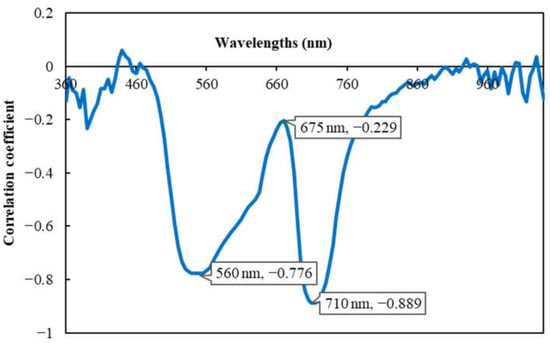
Figure 2.
Correlation coefficients between ‘Fuji’ apple leaf reflectance at each wavelength and chlorophyll content. For all of the wavelengths, 3 characteristic wavelengths (560 nm, 710 nm and 675 nm) and their correlation coefficients are indicated in the graph: the wavelengths (560 nm and 710 nm) show the highest negative correlation with chlorophyll content and the characteristic wavelength (675 nm) represents a peak between the above 2 wavelengths.
3.3. Chlorophyll Content Prediction Model
Based on the above analysis, 3 key wavelengths, i.e., 560 nm, 675 nm and 710 nm, were identified and used to develop an MLR model for chlorophyll content prediction. Figure 3 illustrates the performance of the MLR model for the prediction with both the training and the test data sets. The model achieved high predictive accuracy in the predictions with both the training (R2 = 0.8585 and RMSE = 0.0029 (p < 0.001)) and the test (R2 = 0.8018 and RMSE = 0.0035 (p < 0.001)) data sets, showing high consistency in the model predictions. This result confirmed the usefulness of the above three key wavelengths for estimating the chlorophyll content in apple leaves. These key wavelengths are among the key wavelengths that were selected for estimating the nitrogen content in apple leaves from earlier research [10].
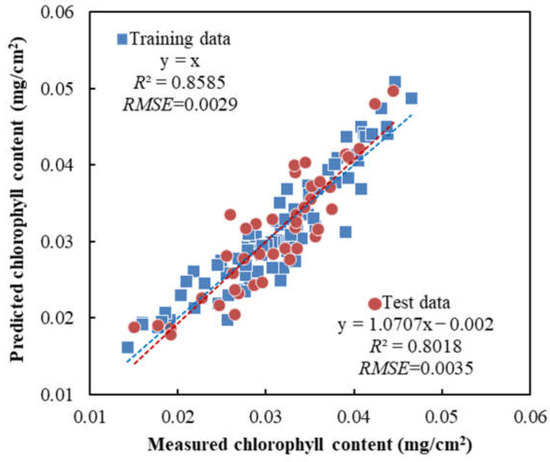
Figure 3.
Measured vs. predicted chlorophyll content in ‘Fuji’ apple leaf samples via the MLR model based on the three key wavelengths. The dashed lines indicate the best fit lines for the training data set (blue) and the test data set (red), respectively.
3.4. Design and Development of Camera Prototype
In designing the camera prototype, three LEDs, each of which emitting light at one of the three key wavelengths, were used as the lighting for the prototype. In addition, another LED at the wavelength of 950 nm was added into the prototype, which, due to its high reflectance, has always been used as a reference in the development of similar devices [56,57]. Since the LEDs 675 nm and 710 nm were not available in the market, it was recommended to replace them with the LEDs 660 nm and 727 nm that had the closest wavelengths to each of the 2 key wavelengths available in the market. Finally, the commercial narrow-band LEDs manufactured by arm-OSRAM (OSRAM GmbH, München, Germany), LP M675 (560 nm), GH DASPA2.24 (660 nm), GF DASPA2.24 (727 nm) and SFH4646 (950 nm) were purchased for the prototype development. The relative spectral emissions of the four LEDs are shown in Figure 4. Each LED emits a light with the peak at/near the key wavelength and a narrow full width at half maximum (FWHM). The emission spectrum of the white LED used in “Rice Scan” (black solid line) and the CIE (International Commission on Illumination) standard photopic luminous efficiency function Vλ (dashed line) are indicated for comparison.
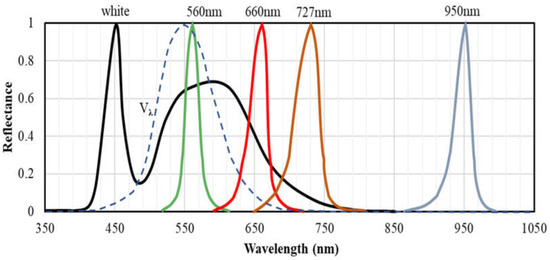
Figure 4.
Relative spectral emission of the 4 specific-wavelength LEDs (LP M675 (560 nm) (green line), GH DASPA2.24 (660 nm) (red line), GF DASPA2.24 (727 nm) (orange line), and SFH4646 (950 nm)) (grey line). The emission spectrum of the white LED used in “Rice Scan” is indicated by black solid line. Vλ is the CIE (International Commission on Illumination) standard photopic luminous efficiency function (blue dashed line). This figure was produced based on the datasheet of each specific-wavelength LED product and the measured emission spectrum of the white LED embedded in “Rice Scan”.
Due to limited space in the small prototype designed, only three LEDs could be added into the prototype. Therefore, two camera prototypes were developed separately, each with a different combination of three LEDs (Table 1). Figure 5 shows the diagrammatic representation of the camera prototypes. The lighting system including three LEDs and a CMOS sensor (OMNIVISION OV7739) were integrated on the upper side of the board. A micro-USB port was designed on the lower part of the prototype.

Table 1.
Narrowband specific-wavelength LEDs used in the two camera prototypes.
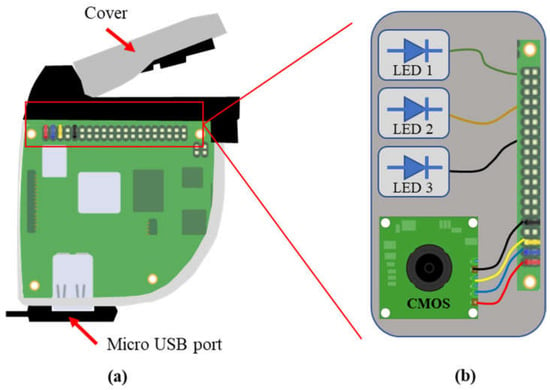
Figure 5.
Diagrammatic representation of the camera: (a) the whole device; (b) the enlarged part of the lighting and sensor system (3 LEDs and 1 CMOS sensor).
The two camera prototypes developed are shown in Figure 6 and Figure 7. The prototype is a palm-sized (70 mm height × 60 mm width × 18 mm depth) and low-weight (60 g) device, equipped with an entrance window of 3 mm × 3 mm and a CMOS sensor that can capture an RGB image with a resolution of 640 × 480 pixels for an area of 2 mm × 2 mm on the leaf sample. During measurement, a plant leaf was placed on the entrance window and the cover was put down closely on the leaf to eliminate the ambient light interference. A specific-wavelength LED was selected with the software developed in parallel, and the image was then captured under the emitted light condition.
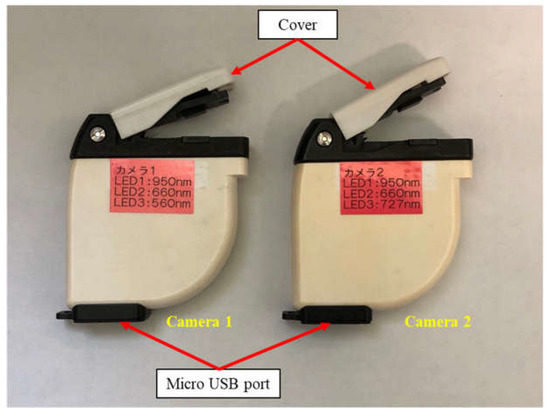
Figure 6.
The two camera prototypes developed with different combinations of three specific-wavelength LEDs. Left: Camera 1 (950 nm, 660 nm and 560 nm); right: Camera 2 (950 nm, 660 nm and 727 nm). The Japanese syllabary characters “カメラ” on the camera prototypes mean “camera” in English.
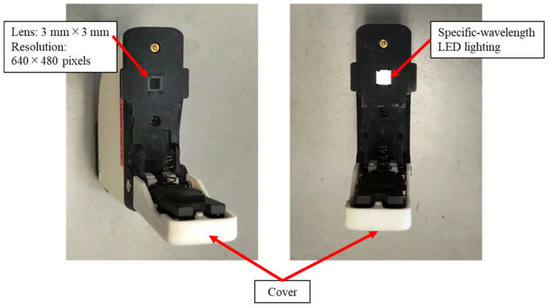
Figure 7.
The camera prototype is equipped with an entrance window of 3 mm × 3 mm and a CMOS sensor that can capture an RGB image with a resolution of 640 × 480 pixels. During measurement, a plant leaf was placed on the entrance window and the cover was put down closely on the leaf to avoid ambient light interference. A specific-wavelength LED was selected with the software, and the image was then captured under the emitted light condition.
3.5. Design and Development of Software for Camera Prototype
A software tool for controlling the camera prototype was designed and developed under the Visual Studio IDE environment (Microsoft Corporation, Redmond, WA, USA). Figure 8 shows the interface of the software to capture images using the camera prototype. In image acquisition, a specific-wavelength LED was first selected, and the light of the selected specific wavelength was emitted when the image was captured using clicking the “Capture” button. The captured image could be saved into a designated folder by clicking the “Save” button. The image shown in the figure was captured for a green leaf under the LED2 (660 nm) lighting condition using the Camera 1 prototype.
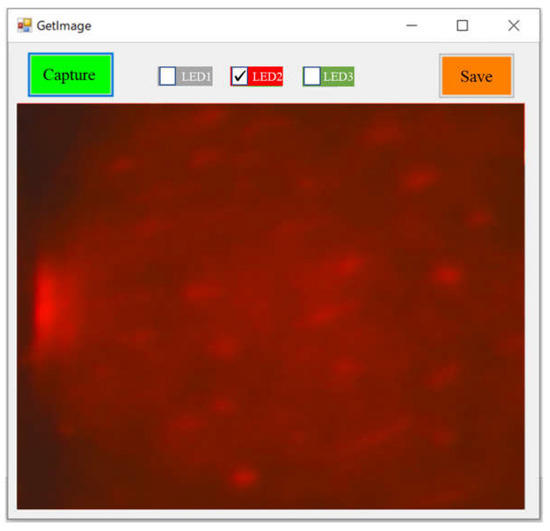
Figure 8.
The interface of the software developed to capture images for the camera prototype.
Figure 9 shows the images captured for the white board (used as a reference) and three apple leaf samples using the two camera prototypes. The images captured under the four LED lighting conditions show significant differences between one another. This suggests the possibility of extracting the reflectance of specific-wavelength light emitted from the built-in LEDs on the leaf from the images, which can be used for estimating the nutrient status of the leaf.
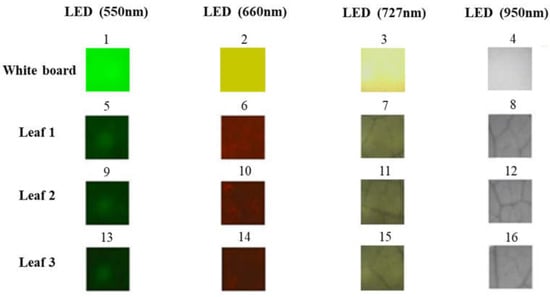
Figure 9.
RGB images for the white board and three leaf samples captured using the camera prototypes under four different specific-wavelength LED lighting conditions. The numbers indicate the number of images taken sequentially with the cameras.
3.6. Relationships between SPAD, CCN Value and Chlorophyll Content
The relationships between the nondestructively measured SPAD and CCN values, and between the SPAD value and the chlorophyll content measured using a destructive, solvent-based pigment-extraction method combined with an absorption spectrometer were investigated. A significant correlation (r = 0.9318 (p < 0.001)) between the measured SPAD values and chlorophyll contents in leaves was found (Figure 10), suggesting the usefulness of the SPAD meter in evaluating the chlorophyll content in the apple leaf. This agrees with the results of numerous previous studies that have confirmed the effectiveness of using SPAD values to assess the nutrient status of a variety of plants and crops [42,43,44,50,51,52].
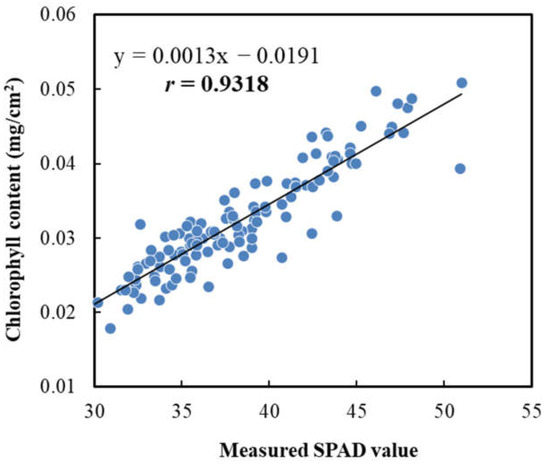
Figure 10.
Correlation between measured SPAD values and chlorophyll content in ‘Fuji’ apple leaves. The line indicates the best fit line.
In addition, there was also a significant correlation (r = 0.9173 (p < 0.001)) between the measured SPAD and CCN values (Figure 11). Although the “SPAD meter” and “Agri Expert CCN” meter were developed for measuring the chlorophyll and nitrogen contents in the leaf plant, respectively, the results measured using these two devices were significantly correlated with each other. Similar results have also been reported in the literature and the reasons have mainly been attributed to the close relationship between the chlorophyll and nitrogen contents in the plant leaf [10,24,38,39]. Our previous study confirmed that the SPAD value not only could be used to accurately predict the chlorophyll content, but it could also be used to predict the nitrogen content in the apple leaf with reasonable accuracy [47]. Furthermore, the CCN value could be directly interpreted into the actual level of nitrogen concentration in the plant leaf [58,59,60]. Therefore, if the camera prototype developed in this research could accurately predict the SPAD and CCN values, it could potentially be used as a new tool to evaluate the nutrient status of plants and crops.
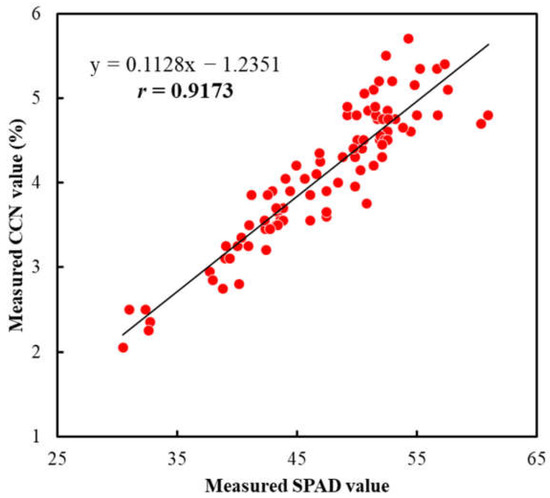
Figure 11.
Correlation between measured SPAD values and measured CCN values for ‘Fuji’ apple leaves. The line indicates the best fit line.
3.7. Performance of SPAD and CCN Prediction Models Based on Images Captured Using Camera Prototype
The SPAD and CCN values for leaf samples predicted using the above models were plotted against the measured SPAD and CCN values, and simple correlation analyses were conducted to investigate the relationships between them. Figure 12 shows the scatter plots of the measured SPAD values vs. the predicted SPAD values. For Camera 1, the models based on the L*, L*a*b* and RGB data all performed excellently in predicting the SPAD values, with correlation coefficients being 0.9211, 0.9394 and 0.9387, respectively. In comparison, for Camera 2, the model based on the L* data obtained a correlation coefficient of 0.8834, which is significantly lower than the same model for Camera 1, and the models based on the L*a*b* and RGB data also performed well with predictive accuracies that were only slightly lower than those for Camera 1. These results indicated that, overall, Camera 1 was superior to Camera 2 in predicting the SPAD values, and the inclusion of color information in addition to the specific-wavelength reflectance intensities could improve the performance of the prediction models.
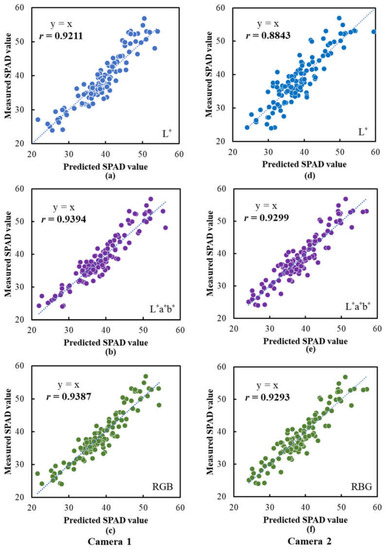
Figure 12.
Performances of the SPAD prediction models based on the data extracted from the images captured using the camera prototypes. Scatter plots of the measured SPAD values vs. the predicted SPAD values are illustrated: (a–c) are the results for the models based on L*, L*a*b* and RGB data, respectively, for Camera 1; (d–f) are the results for the models based on L*, L*a*b* and RGB data, respectively, for Camera 2. The lines indicate the best fit lines.
Figure 13 shows the scatter plots of the measured CCN values vs. the predicted CCN values. Compared to the models for the SPAD values, the models for the CCN values all achieved a relatively lower prediction accuracy. For Camera 1, the correlation coefficients between the measured and the predicted CCN values for the models based on the L*, L*a*b* and RGB were 0.8264, 0.8686 and 0.8644, respectively. Furthermore, the models for Camera 2 performed worse than the corresponding models for Camera 1. Among them, the model based on the L* data obtained the lowest correlation coefficient of 0.6594, and the models based on the L*a*b* and RGB data did not perform satisfactorily, with the predictive accuracies being significantly lower than those for Camera 1. These results indicated that, similarly, Camera 1 was superior to Camera 2 in predicting the CCN values, and the usefulness of color information in improving the performance of prediction models was confirmed. The above results suggest that the images captured using the Camera 1 prototype may contain more nutrient-related information on “Fuji” apple leaves than those captured using the Camera 2 prototype.
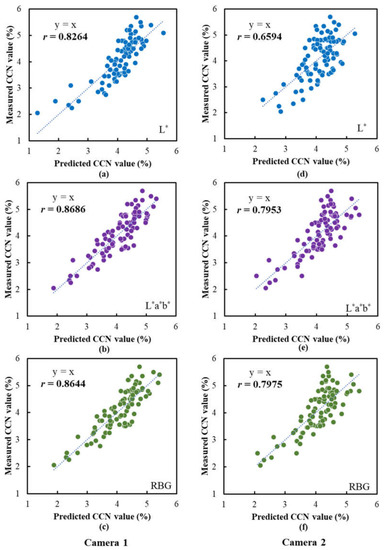
Figure 13.
Performances of the CCN prediction models based on the data extracted from the images captured using the camera prototypes. Scatter plots of the measured CCN values vs. the predicted CCN values are illustrated: (a–c) are the results for the models based on L*, L*a*b* and RGB data, respectively, for Camera 1; (d–f) are the results for the models based on L*, L*a*b* and RGB data, respectively, for Camera 2. The lines indicate the best fit lines.
The above findings demonstrated the potential usefulness of the camera prototypes in evaluating the nutrient status in the apple leaf. Particularly, Camera 1 had a superiority over Camera 2 in predicting both the SPAD values and the CCN values, showing a more potential applicability for real practices in the future. This study serves as a preliminary step toward developing a low-cost, small-size and easy-to-use tool for the evaluation of nutrient status in plants and crops. The new tool is expected to be used as an alternative to the existing commercial tools. Compared to the tools currently available in the market (such as “SPAD”, “GreenSeeker” and “Agri Expert CCN” meters), whose prices range from USD 800 to 2000, the total cost for each camera prototype developed in this study was only between USD 100 and 200. Such a low-cost tool will be very attractive to farmers. Future work will include the development of new versions of the camera prototypes with built-in Wi-Fi capability as well as the development of a mobile application for mobile phones and devices to remotely control the camera. Wi-Fi capability will enable the wireless mobility of the camera, and the new mobile app system is expected to be able to quickly calculate SPAD, CCN and chlorophyll/nitrogen content estimates based on the images captured using the camera, and will show the results on mobile devices in real time. These new features will further increase the usability of the tool in crop nutrient management in the future.
4. Conclusions
Our recent study revealed the possibility of using a simple MLR model based on four narrowband specific wavelengths to estimate the nitrogen content in apple leaves. With an aim to apply the above model in a practical situation, the present research developed a low-cost and small-size camera that could collect narrowband specific wavelength reflectance for evaluating the nutrient status of fruit trees. Two camera prototypes were developed by integrating three independent LEDs of specific wavelengths into a “Rice Scan” device. Using the camera prototypes, we acquired images of ‘Fuji’ apple leaves and investigated the possibility of using the images to estimate the nutrient status indicators obtained by the widely used “SPAD” and “Agri Expert CCN” devices. The results indicated that the data obtained by the Camera 1 prototype had higher correlations with the nutrient status indicators than those obtained by the Camera 2 prototype. This study suggests that the new low-cost and small-size camera with built-in specific-wavelength LED lighting developed in this study can potentially be applied to the evaluation of nutrient status in apple leaves.
Author Contributions
Conceptualization, X.Y. and S.Z.; methodology, X.Y. and S.Z.; software, S.Z.; validation, X.Y. and S.Z.; formal analysis, X.Y., S.A. and M.K.; investigation, S.A., M.K. and F.S.; resources, X.Y. and S.Z.; data curation, S.A., M.K. and F.S.; writing—original draft preparation, X.Y.; writing—review and editing, X.Y. and S.Z.; visualization, X.Y. and S.A.; supervision, X.Y. and S.Z.; project administration, X.Y.; funding acquisition, X.Y. All authors have read and agreed to the published version of the manuscript.
Funding
This work was jointly supported by JSPS KAKENHI, grant numbers JP 16K07968, 19K06306 and 23K05459, and the Strategy I Project of Hirosaki University.
Institutional Review Board Statement
Not applicable.
Informed Consent Statement
Not applicable.
Data Availability Statement
Not applicable.
Acknowledgments
This research was made possible largely due to support from JSPS KAKENHI Grants and Hirosaki University. The authors would like to acknowledge the financial support from these organizations. Special thanks also go to Hiroyuki Yoshimura of Maxell Co. for his support and coordination in the development of the camera prototypes based on our proposed specifications.
Conflicts of Interest
The authors declare no conflict of interest. The funding sponsors had no role in the design of the study.
References
- Aomori Prefecture Apple Countermeasures Council. One Year of Apple Cultivation. Available online: https://www.aomori-ringo.or.jp/kids/cultivation/ (accessed on 12 March 2023).
- Fukuda, H.; Masuda, T. Saving of labor inputs to grow apple fruit. Bull. Natl. Inst. Fruit Tree Sci. 2006, 5, 1–13. [Google Scholar]
- Zaman, Q.U.; Schumann, A.W. Nutrient management zones for citrus based on variation in soil properties and tree performance. Precis. Agric. 2006, 7, 45–63. [Google Scholar] [CrossRef]
- Aggelopoulou, K.; Pateras, D.; Fountas, S.; Gemtos, T.A.; Nanos, G.D. Soil spatial variability and site-specific fertilization maps in an apple orchard. Precis. Agric. 2011, 12, 118–129. [Google Scholar] [CrossRef]
- Aggelopooulou, K.; Castrignanò, A.; Gemtos, T.; Benedetto, D.D. Delineation of management zones in an apple orchard in Greece using a multivariate approach. Comput. Electron. Agric. 2013, 90, 119–130. [Google Scholar] [CrossRef]
- Kumar, P.; Kumar, P.; Sharma, M.; Shukla, A.K.; Butail, N.P. Spatial variability of soil nutrients in apple orchards and agricultural areas in Kinnaur region of cold desert, Trans-Himalaya, India. Environ. Monit. Assess. 2022, 194, 290. [Google Scholar] [CrossRef] [PubMed]
- Schumann, A.W. Precise placement and variable rate fertilizer application technologies for horticultural crop. HorTechnolgy 2010, 20, 30–40. [Google Scholar] [CrossRef]
- Neilsen, G.H.; Neilsen, D.; Forge, T.; Hannam, K. Advances in soil and nutrient management in apple cultivation. In Achieving Sustainable Cultivation of Apples; Evans, K., Ed.; Burleigh Dodds Science Publishing: Cambridge, UK, 2017. [Google Scholar]
- Takebe, M. Recent development in the plant nutritional diagnosis by nondestructive methods. Jpn. Soc. Soil Sci. Plant Nutr. 2009, 80, 63–65. [Google Scholar]
- Ye, X.; Abe, S.; Zhang, S. Estimation and mapping of nitrogen content in apple trees at leaf and canopy levels using hyperspectral imaging. Precis. Agric. 2020, 21, 198–225. [Google Scholar] [CrossRef]
- Curran, P.J.; Dungan, J.L.; Gholz, H.L. Exploring the relationship between reflectance red edge and chlorophyll content in slash pine. Tree Physiol. 1990, 7, 33–48. [Google Scholar] [CrossRef]
- Filella, I.; Serrano, I.; Serra, J.; Peñuelas, J. Evaluating wheat nitrogen status with canopy reflectance indices and discriminant analysis. Crop Sci. 1995, 35, 1400–1405. [Google Scholar] [CrossRef]
- Fageria, N.K.; Baligar, V.C. Enhancing nitrogen use efficiency in crop plants. Adv. Agron. 2005, 80, 97–198. [Google Scholar]
- Erel, R.; Dag, A.; Ben-Gal, A.; Schwartz, A.; Yermiyahu, U. Flowering and fruit set of olive trees in response to nitrogen, phosphorus, and potassium. J. Am. Soc. Hort. Sci. 2008, 133, 639–647. [Google Scholar] [CrossRef]
- Ferreira, R.B.; Leonel, S.; Lima, G.P.P.; Leonel, M.; Minatel, I.O.; Souza, J.M.A.; Monteiro, G.C.; Silva, M.S. Contents of nitrogen compounds during bud break and peach tree performance in response to budburst-inducing products. Sci. Hortic. 2022, 305, 111388. [Google Scholar] [CrossRef]
- Xia, G.; Cheng, L.; Lakso, A.; Goffinet, M. Effects of nitrogen supply on source-sink balance and fruit size of ‘Gala’ apple trees. J. Am. Soc. Hort. Sci. 2009, 134, 126–133. [Google Scholar] [CrossRef]
- Albornoz, F. Crop responses to nitrogen overfertilization: A review. Sci. Hortic. 2016, 205, 79–83. [Google Scholar] [CrossRef]
- Palta, J.P. Leaf chlorophyll content. Remote Sens. Rev. 1990, 5, 207–213. [Google Scholar] [CrossRef]
- Sáez-Plaza, P.; Michałowski, T.; Navas, M.J.; Asuero, A.G.; Wybraniec, S. An overview of the Kjeldahl method of nitrogen determination. Part I. Early history, chemistry of the procedure, and titrimetric finish. Crit. Rev. Anal. Chem. 2013, 43, 178–223. [Google Scholar] [CrossRef]
- Shea, F.; Watts, C.E. Dumas method for organic nitrogen. Ind. Eng. Chem. Anal. Ed. 1939, 11, 333–334. [Google Scholar] [CrossRef]
- Abulaiti, Y.; Sawut, M.; Maimaitiaili, B.; Ma, C. A possible fractional order derivative and optimized spectral indices for assessing total nitrogen content in cotton. Comput. Electron. Agric. 2020, 171, 105275. [Google Scholar] [CrossRef]
- Kaniszewski, S.; Kowalski, A.; Dysko, J.; Agati, G. Application of a combined transmittance/fluorescence leaf clip sensor for the nondestructive determination of nitrogen status in white cabbage plants. Sensors 2021, 21, 482. [Google Scholar] [CrossRef]
- Bajwa, S.G.; Mishra, A.R.; Norman, R.J. Canopy reflectance response to plant nitrogen accumulation in rice. Precis. Agric. 2010, 11, 488–506. [Google Scholar] [CrossRef]
- Wang, Q.; Ye, X.; Li, J.; Xiao, Y.; He, Y. Estimation and visualization of nitrogen content in citrus canopy based on two band vegetation index (TBVI). Spectrosc. Spectr. Anal. 2015, 35, 715–718. [Google Scholar]
- Li, J.; Ye, X.; Wang, Q.; Zhang, C.; Yong, H. Development of prediction models for determining N content in citrus leaves based on hyperspectral imaging technology. Spectrosc. Spectr. Anal. 2014, 34, 212–216. [Google Scholar]
- Padilla, F.M.; Gallardo, M.; Peña-Fleitas, M.T.; De Souza, R.; Thompson, R.B. Proximal optical sensors for nitrogen management of vegetable crops: A review. Sensors 2018, 18, 2083. [Google Scholar] [CrossRef] [PubMed]
- Perry, E.M.; Davenport, J.R. Spectral and spatial differences in response of vegetation indices to nitrogen treatments on apple. Comput. Electron. Agric. 2007, 59, 56–65. [Google Scholar] [CrossRef]
- Schlemmer, M.; Gitelson, A.; Schepers, J.; Ferguson, R.; Peng, Y.; Shanahan, J.; Rundquist, D. Remote estimation of nitrogen and chlorophyll contents in maize at leaf and canopy levels. Int. J. Appl. Earth Obs. Geoinf. 2013, 25, 47–54. [Google Scholar] [CrossRef]
- Thorp, K.R.; Wang, G.; Bronson, K.F.; Badaruddin, M.; Mon, J. Hyperspectral data mining to identify relevant canopy spectral features for estimating durum wheat growth, nitrogen status, and grain yield. Comput. Electron. Agric. 2017, 136, 1–12. [Google Scholar] [CrossRef]
- Main, R.; Cho, M.A.; Mathieu, R.; O’Kennedy, M.M.; Ramoelo, A.; Koch, S. An investigation into robust spectral indices for leaf chlorophyll estimation. ISPRS J. Photogramm. Remote Sens. 2011, 66, 751–761. [Google Scholar] [CrossRef]
- Fitzgerald, G.; Rodriguez, D.; O’Leary, G. Measuring and predicting canopy nitrogen nutrition in wheat using a spectral index—The canopy chlorophyll content index (CCCI). Field Crop. Res. 2010, 116, 318–324. [Google Scholar] [CrossRef]
- Pérez-Patricio, M.; Camas-Anzueto, J.L.; Sanchez-Alegría, A.; Aguilar-González, A.; Gutiérrez-Miceli, F.; Escobar-Gómez, E.; Voisin, Y.; Rios-Rojas, C.; Grajales-Coutiño, R. Optical method for estimating the chlorophyll contents in plant leaves. Sensors 2018, 18, 650. [Google Scholar] [CrossRef]
- Gitelson, A.A.; Merzlyak, M.N. Quantitative estimation of chlorophyll a using reflectance spectra: Experiments with autumn chestnut and maple leaves. J. Photochem. Photobiol. 1994, 22, 247–252. [Google Scholar] [CrossRef]
- Yoder, B.J.; Pettigrew-Crosby, R.E. Predicting nitrogen and chlorophyll concentrations from reflectance spectra (400–2500 nm) at leaf and canopy scales. Remote Sens. Environ. 1995, 53, 199–211. [Google Scholar] [CrossRef]
- Buschmann, C.; Nagel, E. In vivo spectroscopy and internal optics of leaves as basis for remote sensing of vegetation. Int. J. Remote Sens. 1993, 14, 711–722. [Google Scholar] [CrossRef]
- Gitelson, A.A.; Merzlyak, M.N.; Chivkunova, O.B. Optical properties and non-destructive estimation of anthocyanin content in plant leaves. Photochem. Photobiol. 2001, 74, 38–45. [Google Scholar] [CrossRef] [PubMed]
- Gamon, J.A.; Surfus, J.S. Assessing leaf pigment content and activity with a reflectometer. New Phytol. 1999, 143, 105–117. [Google Scholar] [CrossRef]
- van den Berg, A.K.; Perkins, T.D. Evaluation of a portable chlorophyll meter to estimate chlorophyll and nitrogen contents in sugar maple (Acer saccharum Marsh.) leaves. For. Ecol. Manag. 2004, 200, 113–117. [Google Scholar] [CrossRef]
- Cartelat, A.; Cerovic, Z.G.; Goulas, Y.; Meyer, S.; Lelarge, C.; Prioul, J.-L.; Barbottin, A.; Jeuffroy, M.-H.; Gate, P.; Agati, G.; et al. Optically assessed contents of leaf polyphenolics and chlorophyll as indicators of nitrogen deficiency in wheat (Triticum aestivum L.). Field Crop. Res. 2005, 91, 35–49. [Google Scholar] [CrossRef]
- Wood, C.W.; Tracy, P.W.; Reeves, D.W.; Edmisten, K.L. Determination of cotton nitrogen status with a hand-held chlorophyll meter. J. Plant Nutr. 1992, 15, 1435–1448. [Google Scholar] [CrossRef]
- Simorte, V.; Bertoni, G.; Dupraz, C.; Masson, P. Assessment of nitrogen nutrition of walnut trees using foliar analysis and chlorophyll measurements. J. Plant Nutr. 2001, 24, 1645–1660. [Google Scholar] [CrossRef]
- Bijay-Singh; Ali, A.M. Using hand-held chlorophyll meters and canopy reflectance sensors for fertilizer nitrogen management in cereals in small farms in developing countries. Sensors 2020, 20, 1127. [Google Scholar] [CrossRef]
- de Souza, R.; Peña-Fleitas, M.T.; Thompson, R.B.; Gallardo, M.; Grasso, R.; Padilla, F.M. The use of chlorophyll meters to assess crop N status and derivation of sufficiency values for sweet pepper. Sensors 2019, 19, 2949. [Google Scholar] [CrossRef] [PubMed]
- Ramesh, K.; Chandrasekaran, B.; Balasubramanian, T.N.; Bangarusamy, U.; Sivasamy, R.; Sankaran, N. Chlorophyll dynamics in rice (Oryza sativa) before and after flowering based on SPAD (chlorophyll) meter monitoring and its relation with grain yield. J. Agron. Crop Sci. 2002, 188, 102–105. [Google Scholar] [CrossRef]
- Shibayama, M.; Akiyama, T.A. A spectroradiometer for field use VII radiometric estimation of nitrogen levels in field rice canopies. Jpn. J. Crop Sci. 1986, 55, 439–445. [Google Scholar] [CrossRef]
- Ali, A.M.; Thind, H.S.; Sharma, S.; Varinderpal-Singh. Prediction of dry direct seeded rice yields using chlorophyll meter, leaf color chart and GreenSeeker optical sensor in northwestern India. Field Crop. Res. 2014, 161, 11–15. [Google Scholar] [CrossRef]
- Ye, X.; Abe, S.; Zhang, S.; Yoshimura, H. Rapid and non-destructive assessment of nutritional status in apple trees using a new smartphone-based wireless crop scanner system. Comput. Electron. Agric. 2020, 173, 105417. [Google Scholar] [CrossRef]
- Varinderpal-Singh; Bijay-Singh; Yadvinder-Singh; Thind, H.S.; Gobinder-Singh; Satwinderjit-Kaur; Kumar, A.; Vashistha, M. Establishment of threshold leaf colour greenness for need-based fertilizer nitrogen management in irrigated wheat (Triticum aestivum L.) using leaf colour chart. Field Crop. Res. 2012, 130, 109–119. [Google Scholar] [CrossRef]
- Bijay-Singh; Sharma, R.K.; Jaspreet-Kaur; Jat, M.L.; Martin, K.L.; Varinderpal-Singh; Yadvinder-Singh; Chandna, P.; Choudhary, O.P.; Gupta, R.K.; et al. Assessment of the nitrogen management strategy using an optical sensor for irrigated wheat. Agron. Sust. Dev. 2011, 31, 589–603. [Google Scholar] [CrossRef]
- Neilsen, D.; Hogue, E.J.; Neilsen, G.H.; Parchomchuk, P. Using SPAD-502 values to assess the nitrogen status of apple trees. HortScience 1995, 30, 508–512. [Google Scholar] [CrossRef]
- Chapman, S.C.; Barreto, H.J. Using a chlorophyll meter to estimate specific leaf nitrogen of tropical maize during vegetative growth. Agron. J. 1997, 89, 557–562. [Google Scholar] [CrossRef]
- Chang, S.X.; Robison, D.S. Nondestructive and rapid estimation of hardwood foliar nitrogen status using the SPAD-502 chlorophyll meter. For. Ecol. Manag. 2003, 181, 331–338. [Google Scholar] [CrossRef]
- Mackenney, G. Absorption of light by chlorophyll solutions. J. Biol. Chem. 1941, 140, 315–322. [Google Scholar] [CrossRef]
- Pearson, K. Notes on regression and inheritance in the case of two parents. Proc. R. Soc. Lond. 1895, 58, 240–242. [Google Scholar]
- Kotera, H. Development of color space. J. Imaging Soc. Jpn. 2004, 43, 73–81. [Google Scholar]
- Song, D.; Qiao, L.; Gao, D.; Li, S.; Li, M.; Sun, H.; Ma, J. Development of crop chlorophyll detector based on a type of interference filter optical sensor. Comput. Electron. Agric. 2021, 187, 106260. [Google Scholar] [CrossRef]
- Brown, L.A.; Williams, O.; Dash, J. Calibration and characterisation of four chlorophyll meters and transmittance spectroscopy for non-destructive estimation of forest leaf chlorophyll concentration. Agric. For. Meteorol. 2022, 323, 109059. [Google Scholar] [CrossRef]
- Sawada, T.; Tanaka, M.; Yoshikawa, T. Relationship between values of leaf nitrogen content analyser and values of a chlorophyll meter. Bull. Hyogo Pre. Agri. Inst. 2001, 49, 14–16. [Google Scholar]
- Ida, R. Measurement of nitrogen content in rice fresh leaf by the near infrared transmission method. Jpn. Soc. Soil Sci. Plant Nutr. 2001, 72, 676–678. [Google Scholar]
- Ida, R. Relationship between chemical analyzed nitrogen content, CCN value and SPAD value in flag leaves of cv. Koshihikari for the ripening period. Jpn. J. Crop Sci. 2006, 75, 550–553. [Google Scholar] [CrossRef]
Disclaimer/Publisher’s Note: The statements, opinions and data contained in all publications are solely those of the individual author(s) and contributor(s) and not of MDPI and/or the editor(s). MDPI and/or the editor(s) disclaim responsibility for any injury to people or property resulting from any ideas, methods, instructions or products referred to in the content. |
© 2023 by the authors. Licensee MDPI, Basel, Switzerland. This article is an open access article distributed under the terms and conditions of the Creative Commons Attribution (CC BY) license (https://creativecommons.org/licenses/by/4.0/).